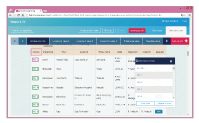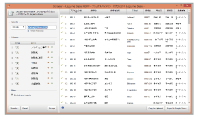|
■Bioresources information is available at the following URLs
|
 |
|
Has a long dispute begun about whether DNA-sequence information will become a subject of the Nagoya Protocol ? - Report of SBSTTA20 -
Mutsuaki Suzuki (Director, Intellectual Property Unit, National Institute of Genetics)
The meeting of the Ad Hoc Technical Expert Group (AHTEG) on Synthetic Biology at the Convention on Biological Diversity (held in September 2015) advised that "the construction of a system to clarify digital information on genetic resources for their access and benefit-sharing shall be requested to the meeting of the Conference of the Parties serving as the meeting of the Parties to the Nagoya Protocol (COP-MOP)." As a result, DNA-sequence information may become subject to the Nagoya Protocol. If DNA information on genetic resources becomes subject to monitoring (similar to material transfer), it is presumed that scientific research will be greatly affected.
Subsequently, the 20th meeting of the Subsidiary Body on Scientific, Technical, and Technological Advice (SBSTTA20) was held at the International Civil Aviation Organization (ICAO) building in Montreal in April 2016. The subject of how to lead the debate on DNA-sequence information was discussed, as well as how to lead and define the debate on synthetic biology. In this article, the report on SBSTTA20 and our correspondence about the debate on DNA-sequence information are examined. |
What is synthetic biology ? |
When listening to synthetic biology, many scientists recall "science and technology to create organisms," which is represented by the artificial synthesis of genomes. However, the recognition of synthetic biology in the Convention of Biological Diversity is larger than the artificial synthesis of genomes. It includes techniques for creating "goods equivalent to natural products using modern biotechnologies."
Although only living organisms are subject to the Cartagena Protocol, DNA (i.e., constituent elements) and products (i.e., creatures) to be used are also subject to the debate on synthetic biology, and the debate has been advanced. Developing countries argue that their farmers are greatly affected by substitutes for natural products (both socially and economically), and cite shea butter, cacao, vanillin, artemisinin, and saffron as examples. |
The debate about the definition |
In the AHTEG meeting, Japan, Brazil, and the United Kingdom opposed the proposed definition: “Synthetic biology is a new field for the further development of modern biotechnologies for understanding, designing, redesigning, producing, and modifying genetic resources, living organisms, and biological systems, in which science, technology, and engineering are combined.” This opposition is due to the fact that the range of definitions was too wide.
However, the definition was not allowed to be changed. Opinions about how to handle the definition differs among countries. Two proposals were written:
-
"The results of the debate are accepted, but the applicability criteria must be examined further"(supported by, e.g., Canada and Australia).
- "The definition is considered to be appropriate" (supported by, e.g., Philippines).
As a whole, the specifics of the definition remain undecided. Moreover, it is also still undecided whether social, cultural, and ethical considerations will be included in risk assessment.
Regarding how to lead the debate on synthetic biology, the wishes of each country were considered. It was decided that the online forum would be continued after the 13th meeting of the Conference of the Parties at the Convention on Biological Diversity (COP13), and the definition of synthetic biology would be continuously debated at the AHTEG meeting. For synthetic biology (which became a new, urgent issue) to be a formal subject for discussion at COP-MOP, further investigation would need to be conducted. |
The debate about handling DNA-sequence information |
During the debate about handling DNA-sequence information at the AHTEG meeting, a developing country said that "if DNA sequence information is given to the corresponding country in advance, genetic resources may be transferred without obtaining the prior informed consent." In response, the AHTEG meeting advised that "the construction of a system to clarify digital information on genetic resources for their access and benefit-sharing shall be requested to COP-MOP."
In SBSTTA20, the United Kingdom, Belgium, Malaysia, and Japan opposed the request to COP-MOP. However, when the European Union, which chaired SBSTTA20, strongly advanced the discussion, only Japan continuously opposed the request. On that day, the request remained undecided, due to Japan's opposition. However, the next day, Japan said that they had unfortunately accepted this request. After that, Canada opposed the request because it had obtained the opinion of its government. Subsequently, the request to COP-MOP ultimately remains undecided.
Regarding how to lead the debate on the current and future use of DNA-sequence information (on genetic resources for accessing and benefit-sharing), two proposals of "the decision of this matter [were] requested to COP-MOP." Also, "after discussing this matter in the AHTEG meeting similar to the present situation, the decision of this matter [was] requested to COP-MOP." They were jointly written. Thus, this matter remains undecided, and it will be discussed at COP13.
|

Photo. 1. Art object displayed in the ICAO building |
|

Photo. 2. Debate in SBSTTA20 |
If the clarification of the current and future use of DNA-sequence information is requested to COP-MOP, the clarification may become subject to the Nagoya Protocol. As a result, the Parties to the Nagoya Protocol may be obliged to construct a system to monitor DNA-sequence information. For example, when a company uses genome information in a public database for its commercial purpose, the company may be requested to return its profits to the country providing that information. As a result, there is an apprehensive feeling that the use of DNA-sequence information is restricted. Simultaneously, the consciousness of the company providing DNA-sequence information may excessively rise.
If the above-mentioned advice is accepted at COP13 (which will be held in December 2016), it will be a formal subject for discussion in COP-MOP3 (which will be held in 2018). At present, whether or not Japan will become a Party to the Nagoya Protocol in 2018 is unclear. The opinion of Canada, Australia, and New Zealand is similar to that of Japan; they have not ratified the Nagoya Protocol.
Therefore, there is a possibility that the debate on DNA-sequence information will advance to COP-MOP3, but Japan and the other countries in agreement have no right to speak about it. Such circumstances must be avoided.
It is needless to say that at present, the debate on DNA-sequence information is in the stage of not knowing whether or not it is beginning. When the history of negotiating the Convention of Biological Diversity is considered, it will take a long time to implement its actual use—starting with the inauguration of the debate on DNA-sequence information.
The following matters must be investigated and analyzed as basic information for future debates:
- What type of effect will be exerted if DNA sequence information becomes subject to the Nagoya Protocol?
- Is there any example that illustrates that profit-sharing is damaged due to DNA sequence information?
- What is each country’s trend for the regulation of DNA-sequence information?
Regarding DNA-sequence information, we want to obtain opinions from scientific communities. Please do not hesitate to send us your opinions at msuzuki@nig.ac.jp.
|
|
|
|
Introducing Web Scraping Tools |

Have you ever been in a situation where you had to manually copy tabular data published on the Web to spreadsheet software because the website did not provide any means for downloading the data? Such manual work can be laborious, especially if the data volume is large. In this article, I will introduce three Web scraping tools that can greatly reduce such manual work.
|

Microsoft Excel Web Query
Excel has a built-in function called Web Query that can import data from external sources (Fig. 1).
Using Web Query, you can import any tabular data published on a target website by choosing from the list of available tables (Fig. 2).
You can choose which tables to import in cases where there are multiple tables on the same page. Additionally, you can configure an automatic update, which automatically updates the imported data upon opening the Excel file, if the data from the original website has been updated.

"import.io"
This is a free website that offers a scraping service.
URL:https://www.import.io/
By simply entering the URL of a target webpage into import.io, the online service automatically recognizes tabular data on the page and captures it.
Using the Web viewer on import.io, you can select tables to be extracted as well as edit data columns (Fig. 3).
If there are links inside a table, you can also extract link URLs or the images to which they are linked. If the column structure is identical, you can also extract and merge multiple tables from different webpages. The extracted data is saved on the user’s own page, and you can view it online or download it to a CSV file.

Google Chrome Scraper Extension
Scraper in the Google Store:
https://chrome.google.com/webstore/detail/scraper/
mbigbapnjcgaffohmbkdlecaccepngjd
Scraper is a Google Chrome extension that can be used to extract HTML data from webpages (Fig. 4). You can drag and select parts of a table on a webpage, and then activate the extension in order to extract data from the whole table (Fig. 5).
The extension can also be used to extract other data by specifying HTML tags and CSS attributes. With Scraper, you can use your mouse to re-order and edit data columns. Extracted data can be exported to Google Spreadsheets with a single click, viewed on the Web, or downloaded as CSV or as an Excel file. |
|

Fig. 1. Excel Web Query

Fig. 2. Selecting tables to import

Fig. 3. Selecting data to extract
 Fig. 4. Scraper icon
Fig. 4. Scraper icon

Fig. 5. Screen showing Scraper in action
|
By using Web scraping tools, such as those introduced in this article, you can efficiently convert data published on webpages into usable data. Furthermore, Scraper integrates with Google Spreadsheets, a platform that is suited for sharing data with other users, making it effective for collaborative data analysis.
I was unable to explain the use of each of the tools in detail; however, they are all intuitive to use. I would encourage you to make use of them.
(Takamori Inaki, Genetic Resource Center) |
|
|